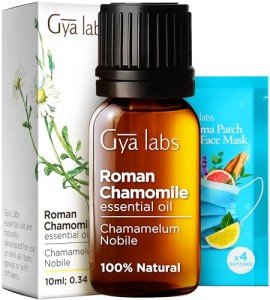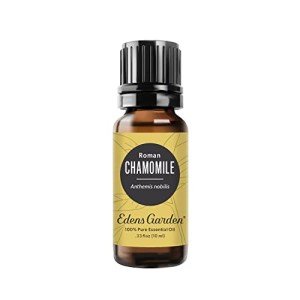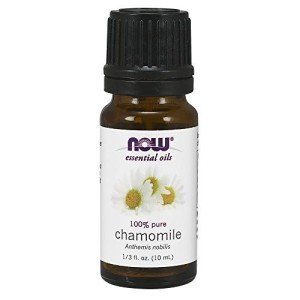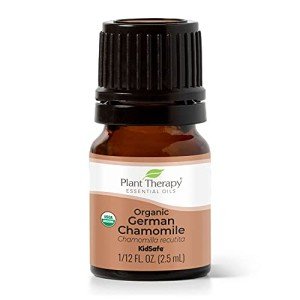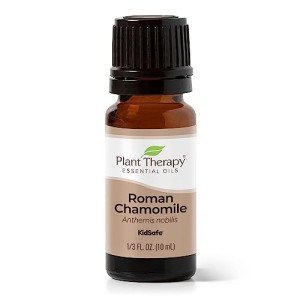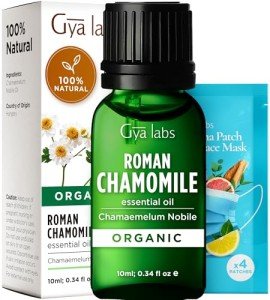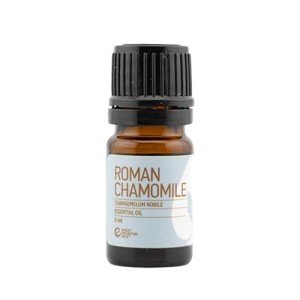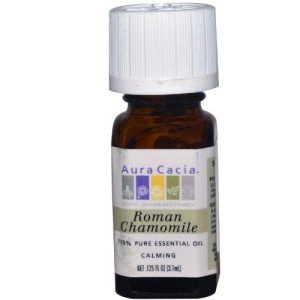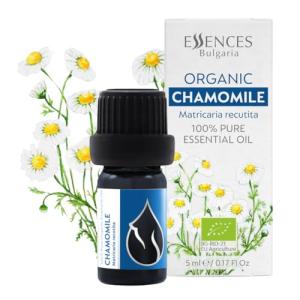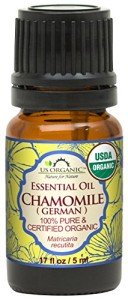What is Chamomile Essential Oil?
Chamomile essential oil is typically derived from either German chamomile (Matricaria chamomilla) or Roman chamomile (Chamaemelum nobile), both of which belong to the Asteraceae family. While both types of chamomile have similar therapeutic properties, German chamomile is more commonly used in essential oil production due to its higher content of the active compounds. Chamomile oil is extracted through steam distillation from the flowers of the plant, resulting in an oil that is known for its sweet, apple-like fragrance and its powerful soothing effects on both the skin and mind.
Chamomile essential oil is often used in skincare formulations due to its anti-inflammatory, antioxidant, and antimicrobial properties, making it ideal for sensitive or irritated skin. It is also used in aromatherapy for its calming effects, helping to reduce stress, anxiety, and promote restful sleep.
Chemical Composition of Chamomile Essential Oil
Chamomile essential oil contains a variety of chemical compounds, many of which contribute to its therapeutic and cosmetic benefits. The two main types of chamomile essential oils—German and Roman chamomile—differ slightly in their chemical composition, but both are rich in powerful anti-inflammatory and skin-healing compounds. Some of the key constituents in chamomile essential oil include:
-
Bisabolol (Alpha-Bisabolol) (30-50%): One of the most significant active compounds in chamomile oil, bisabolol is known for its anti-inflammatory, antimicrobial, and soothing properties. It helps calm irritated skin, promote healing, and reduce redness or swelling. Bisabolol also has antioxidant properties, which protect the skin from free radical damage, making it a valuable ingredient in anti-aging skincare products.
-
Chamazulene (1-15%): Chamazulene is a potent anti-inflammatory compound formed during the distillation process. It contributes to the deep blue color of German chamomile oil and plays a key role in reducing inflammation and soothing skin irritation. Chamazulene also has antioxidant properties, helping to protect the skin from oxidative damage and stress.
-
Farnesene (~5%): This compound gives chamomile its slightly sweet and herbaceous aroma. Farnesene also has antimicrobial and anti-inflammatory effects, contributing to the oil’s ability to calm the skin and prevent infection.
-
Cis-β-Farnesene (~2-4%): Another compound in chamomile oil with antimicrobial and antifungal properties, cis-β-farnesene further supports chamomile’s skin-protective benefits.
-
Sesquiterpenes (2-5%): These compounds, including α-bisabolol and β-caryophyllene, contribute to chamomile’s anti-inflammatory and calming properties. They are particularly useful for reducing skin irritation and promoting overall skin health.
-
Aromatic Esters (Up to 2%): These compounds provide chamomile essential oil with its characteristic soothing, sweet, and herbaceous fragrance. Esters are known for their relaxing and calming effects, making chamomile oil a popular choice in aromatherapy.
Benefits of Chamomile Essential Oil in Handmade Soap
When incorporated into handmade soap, chamomile essential oil offers a range of benefits for the skin. Here are some of the key advantages of using chamomile oil in soap formulations:
1. Soothes Irritated and Sensitive Skin
Chamomile essential oil is renowned for its ability to calm and soothe irritated or inflamed skin. Bisabolol and chamazulene, the two primary compounds in chamomile, are known for their anti-inflammatory properties, making chamomile oil an ideal ingredient in soaps designed for sensitive skin. It can help reduce redness, itching, and swelling caused by conditions such as eczema, dermatitis, and sunburn.
2. Promotes Skin Healing
Chamomile’s antibacterial and antimicrobial properties make it an excellent choice for promoting skin healing. Whether used for cuts, scrapes, or acne, chamomile essential oil can help prevent infection and accelerate the skin’s natural healing process. Its calming effect also helps alleviate the discomfort that often accompanies skin irritations.
3. Gentle on Dry or Damaged Skin
Chamomile oil is ideal for dry, flaky, or damaged skin. It helps restore moisture balance, soothing the skin without causing further irritation. Its hydrating and anti-inflammatory properties make it an excellent option for soothing chapped or cracked skin, leaving it soft and smooth after use.
4. Reduces the Appearance of Blemishes
Chamomile’s antibacterial and anti-inflammatory properties make it effective for treating acne and other blemishes. By helping to reduce inflammation and prevent bacterial growth, chamomile oil can help clear up acne breakouts while also reducing the appearance of scarring over time.
5. Calming and Relaxing Scent
Chamomile essential oil’s gentle, soothing fragrance makes it a popular choice for relaxation. When used in soap, it can create a calming sensory experience, helping to relieve stress and promote relaxation during bath time. Chamomile’s calming effects can also contribute to better sleep when used before bedtime.
Chamomile Essential Oil in Cosmetics
Chamomile oil is widely used in cosmetics for its skin-soothing and anti-inflammatory benefits. It is especially beneficial for people with sensitive or reactive skin, as it helps reduce irritation and promotes a healthy, glowing complexion. Here are some of the ways chamomile essential oil is used in cosmetic formulations:
1. Anti-Aging Properties
Chamomile essential oil is rich in antioxidants, including chamazulene and bisabolol, which help protect the skin from free radicals and environmental stressors that contribute to premature aging. It can be found in anti-aging creams, serums, and lotions designed to reduce the appearance of fine lines and wrinkles, while promoting skin regeneration and collagen production.
2. Reduces Redness and Puffiness
Chamomile’s ability to reduce inflammation and promote circulation makes it an excellent ingredient for reducing redness, puffiness, and under-eye bags. It can be incorporated into facial oils, eye creams, and serums to help calm irritated or sensitive skin and reduce swelling.
3. Balances Dry and Oily Skin
Chamomile essential oil helps balance the skin’s natural oils, making it suitable for both dry and oily skin types. It can be used in moisturizers to hydrate and replenish dry skin while also helping to regulate oil production, preventing excess sebum that could lead to clogged pores or acne.
4. Gentle Cleanser for Sensitive Skin
Chamomile essential oil is often used in facial cleansers and gentle exfoliators for sensitive skin. It helps cleanse the skin without stripping away its natural oils, leaving the skin feeling refreshed and soothed. Its anti-inflammatory and antimicrobial properties also help keep the skin clear and healthy.
5. Calms Irritated Scalps
Chamomile essential oil is effective for soothing an irritated or itchy scalp. When added to shampoos or scalp treatments, chamomile oil can help alleviate dryness, flakiness, and inflammation, promoting overall scalp health and potentially improving hair growth by reducing inflammation around the hair follicles.
How to Use Chamomile Essential Oil in Handmade Soap and Cosmetics
In Handmade Soap
Chamomile essential oil can be added to both cold-process and melt-and-pour soap recipes. The typical usage rate is about 0.5–1% of the total weight of oils in the recipe. In cold-process soap, chamomile oil is added at the "trace" stage, when the soap batter begins to thicken. In melt-and-pour soap, it is added once the base is fully melted, ensuring that the essential oil maintains its full therapeutic properties.
To further enhance the benefits of chamomile, dried chamomile flowers can be incorporated into the soap for added texture and visual appeal.
In Cosmetics
Chamomile essential oil is typically diluted in a carrier oil (such as jojoba or sweet almond oil) before being added to facial creams, serums, or lotions. For body lotions and other cosmetic products, chamomile essential oil can be included at a concentration of up to 3%, while more delicate formulations like facial oils should use a lower concentration of around 1-2%.
Chamomile is also commonly used in facial masks, shampoos, and conditioners for its calming and soothing effects.
Conclusion
Chamomile essential oil is a gentle yet powerful ingredient in handmade soaps and cosmetics, offering a variety of skin benefits. Its anti-inflammatory, antibacterial, and antioxidant properties make it an excellent choice for soothing irritated skin, reducing redness, and promoting skin healing. Whether you're creating skincare products for sensitive skin, anti-aging treatments, or soothing bath products, chamomile oil provides natural, effective solutions that help nurture the skin while promoting relaxation. Its calming aroma and skin-loving properties make chamomile essential oil a beloved addition to any beauty routine.
